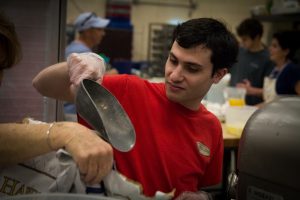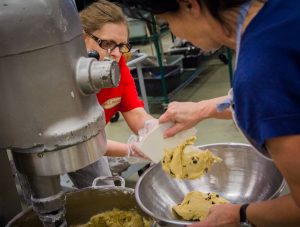
Ingredients for a Supportive Community
By Denise Resnik
Something fell on the sidewalk. I saw it from a distance. I also saw other cars speeding by.
As I approached, what I saw was an elderly woman lying motionless on the side of the street. I pulled over immediately, explaining to Matt that he needed to stay in the car, stuffed with 480 eggs and hundreds of pounds of biscotti ingredients as we were on our way to prepare SMILE Biscotti batter.

Denise’s son Matt
Fortunately, Catherine is ok. I was relieved to see she was conscious and ruled out 911 at her request. Then together we dusted her off, found her glasses and applied some tissue to the scratches on her face. She didn’t live far, but there was no way I could wedge her into our car. That’s when I looked up and saw another stopped car.
Two millennials rushed over to check on us, then kindly offered to deliver her home. I followed and observed as she waived goodbye and blew kisses.
Oh, the kindness of humanity at its best. We stop for people who are older or people with obvious physical disabilities. But will someone stop and recognize someone needing help? What happens when the disability is not so obvious, or in Matt’s case, autism?
I’m banking on awareness and kindness, the most critical ingredients to creating a supportive community. And the need for community support is significant.
At least 60 percent of youth with autism have at least two health or mental health conditions in addition to the autism spectrum disorder, according to the A.J. Drexel Autism Institute Life Course Outcomes’ 2015 National Autism Indicators Report. In addition, one in four young adults with autism are socially isolated, according to the same data.
I’ve often wondered who will catch Matt’s fall, recognize his special needs and his oh so beautiful mind,

Inside the SMILE kitchen
talents and heart. Who will discern Matt from his autism and medication side effects and be the diligent sleuth always searching for answers to the issue of the day, week, month or year?
While I cannot expect others to care as much as I do, I do expect a supportive community to desire similar outcomes, which are in our collective best interest. Greater independence and higher quality of life will significantly reduce cost to society. Moving the needle on positive outcomes will increase job satisfaction for direct support service providers, educators and medical professionals. For parents and family members, peace of mind is priceless.

Inside the SMILE kitchen
Matt and I arrived at the commercial kitchen in time to greet 10 of his SMILE Biscotti co-workers and volunteers, who prepared batter for 3,000 pieces. Matt and his helpers, with dedication, determination and care, cheerfully spent the afternoon baking, learning employment and social skills in the process.
As we conclude another Autism Awareness and Acceptance Month, and reflect on the enormous number of articles about our cause, hopeful and soulful stories of personal triumphs, and scientific advancements, I am mindful that should Matt be struggling and in need of help, that a passerby would stop and kindly help him to his feet again.
Denise D. Resnik is the founder, president, and CEO of First Place® AZ, a charitable nonprofit real estate and community developer focused on individuals with autism and other neurodiverse populations. She was inspired to start First Place for her son, Matt, who was diagnosed with autism at age 2. In 1997, she co-founded the nonprofit Southwest Autism Research & Resource Center (SARRC). She is also the founder and CEO of DRA Collective, a Phoenix-based public relations, marketing, and communications firm.




